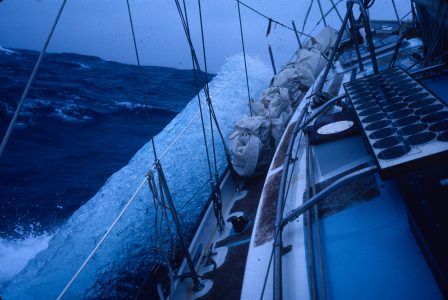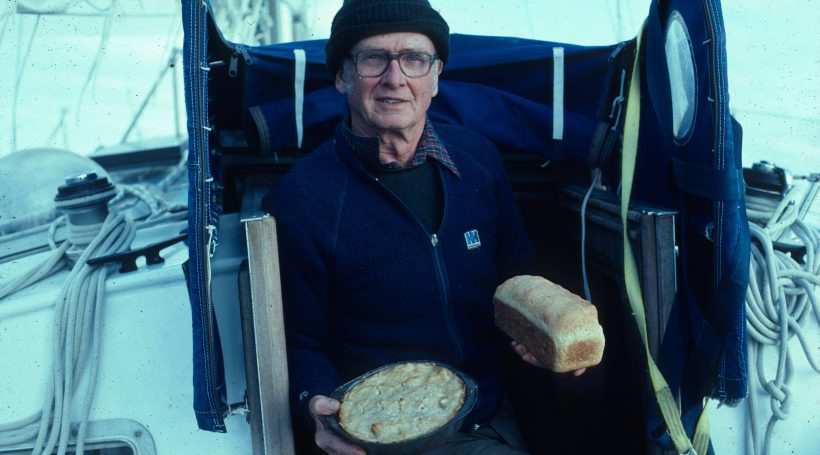It’s the dead of night and the black waters of the New York shipping lanes are all Marv Creamer can see. He’s on night watch but the fog is so thick, he might as well be sleeping. A massive tanker moves toward his little craft in the darkness, completely invisible until it’s close enough that he has to look straight up 100 feet over his head to see the bridge. The tanker bristles by, just feet away, blasting its foghorn.
Creamer remembers that it “rattled every piece of china wear, nuts and bolts, spare parts. It was like we were on a giant paint-shaker. It was horrifying.”
Creamer survived this brush with mortality and a thousand others in a seafaring career that began as an amateur obsession and culminated with a singular accomplishment never achieved in human history before or since. From December 21 of 1982 to March 17 1984, Creamer became the only man ever to sail around the world without the aid of navigational instruments.
For some, the idea of driving to Wawa without GPS is terrifying.
 But Creamer sailed around the world without a sextant, without a compass, without even a watch. Over a span of more than 500 days, Creamer overcame torn sails, weather conditions of unspeakable power, and his own uncertainty to traverse 30,000 nautical miles. His only navigational aid was a comprehensive working knowledge of the stars over his head, the wind at his back and the currents beneath his feet.
But Creamer sailed around the world without a sextant, without a compass, without even a watch. Over a span of more than 500 days, Creamer overcame torn sails, weather conditions of unspeakable power, and his own uncertainty to traverse 30,000 nautical miles. His only navigational aid was a comprehensive working knowledge of the stars over his head, the wind at his back and the currents beneath his feet.
At 97 years of age, former Glassboro State College (today Rowan University) professor Marv Creamer is exactly what you’d expect from a man with the guts to circumnavigate the globe on a vessel the size of a freshman dorm room. He’s bold, energetic and as lucid as he is knowledgeable.
These were the virtues that fueled him to hop into a 36-foot boat called Globe Star and depart from Cape May just three years after his retirement from teaching. That’s right. Creamer has accomplished more in his retirement than. . .well anybody.
To hear Marv describe it today, he never had a choice.
“I was taken hostage by an idea,” he explains. “I got hit with an idea in the middle of the night, in the middle of the Atlantic and it didn’t let go for ten years.”
Creamer was a geography professor by trade. However, he admits without hesitation that his sailing ambitions were far more personal than professional. Born in Vineland when Woodrow Wilson was president and a gallon of gas cost about 16 cents, Creamer remembers sailing Parvin Lake on his father’s homemade boat as young as 5 years old.
He bought his own boat in 1970, a vessel called the Scotia, which had already been around the world without him. He didn’t know it at the time, but he began training for a journey that would write him into the history books. On his first successful expedition to the Azores, Creamer was struck by an epiphany.
He and his two-man crew had struggled for days to repair a broken compass light. As Creamer tells it, the compass light seemed to break every single night, but for a different reason each time. Creamer was the boat’s chief navigator, chief cook and chief repairman. Therefore, among his many responsibilities, it was his charge to keep the navigational equipment working.
One night, as Creamer sat watch, the compass light went out…again. He was too tired to fix it. So he sat back, looked up at the stars and made his way. This was an exhilarating moment. Creamer was free of navigational tethers, floating at the mercy of the seas and his own senses, just a sailor, his boat and the heavens.
It was in this solitude that he had his revelation.
 Creamer insists that “you need to imagine sitting in the dark under the stars, trying to make a five hour watch go by. You had to keep something rattling around in your head. It was nice to think about my position by the stars.”
Creamer insists that “you need to imagine sitting in the dark under the stars, trying to make a five hour watch go by. You had to keep something rattling around in your head. It was nice to think about my position by the stars.”
He began to wonder, “How would it feel out here without all the nautical toys?”
The answer that kept coming back to him from the dark waters: “It would be fun to try.”
Creamer began experimenting with various methods of hands-free navigation. He was fairly convinced that by observing a combination of winds, currents, wildlife and constellations, he could achieve a reasonable approximation of his latitudinal and longitudinal position. He even coined his own navigational science, which he calls Sky Geometry.
He put his theory into practice with successful runs to Ireland and Africa. He found the challenge of navigating without instruments compelling and difficult but eminently manageable.
Slightly less manageable and possibly more difficult was the task of convincing his wife Blanche to let him go. Blanche had always been supportive of her husband’s passion, even helping him to procure supplies on occasion. But this trip was different for obvious reasons.
Creamer remembers that “as things progressed, things got a little heavier. There came the day when Blanche brought out what I called her big artillery piece, her big gun. She said, ‘You’re the best friend I’ve ever had. Why would I want to part with you for a year and a half?’”
She had a great point. But it was out of his hands. He knew he couldn’t live with himself if he didn’t try.
“There was going to be an emotional cost,” he recalls. “There was no doubt about it. It would really have been life-changing.”
Ultimately, Creamer asked his wife “would you really want a husband whose dream died inside of him?”
“Fine,” she said, “but don’t expect the provisioning that I’ve given you in the past.”
They both knew she was lying.
Indeed, Creamer recalls that when he and his two man crew would eventually make landfall during their voyage, “she schlepped 180 pounds of gear to Tasmania that I needed desperately.”
Creamer describes himself as a problem-solver by nature. It was fun for him to “think about doing the impossible.” From the moment that his voyage began, Creamer would get this kind of fun in heavy doses.
He battled gale force winds, cabin fires, broken valves and a near-grounding. . . all in the first 72 hours.
He dislocated his shoulder attempting to bring a sail down in heavy storm winds. At one point, off the coast of Tasmania, winds rolled the ship until it was all but upside down. The cabin was in shambles.
At another point, he inadvertently docked his craft near a secret British airport just under construction in the recently disputed Falkland Islands. Following what Creamer describes as an arrest so polite he didn’t know it happened until he was released, the Royal Air Force furnished his crew with food, supplies, repairs and good cheer.
Perhaps most incredibly, Creamer guided his ship unscathed through the famously rough waters of Drake Passage, which lay between Cape Horn in South America and the icy waters north of Antarctica. As they entered Drake Passage, Creamer remembers, “the wind blew 70 mph for three days. There was a noise like we were being hit by a Mack truck. We wore survival suits so if we fell overboard we’d live for 48 hours instead of dying immediately.”
Creamer’s crew survived the Passage and everything else the globe could throw at them. Creamer describes individual moments of his 500-day voyage as “burned into my brain.”
Among the surreal images that can only come from remoteness of this extremity, Creamer remembers waters teeming with whales and porpoises, the sheer 60 meter cliffs of the Great Australian Bight and one seven week stretch in which his boat encountered nothing resembling life or civilization of any kind.
When he returned home, 1500 were on hand to greet him. A friend presented him with a placard that read, ‘The best planning is no substitute for dumb luck.’ And by most reports, while Creamer was given a hero’s welcome, Blanche received a slightly louder applause at the homecoming ceremony. Marv and Blanche would enjoy nearly 60 years of happy marriage before her passing in 2005.
Today, Creamer is, by his own description and in the paraphrased words of pastoral poet Oliver Goldsmith, “husbanding life’s taper to a close.” But you wouldn’t know it to talk to him.
Creamer’s adventuring days are behind him, though not as far as you’d think. He remarried two years ago, sailed to Bermuda with his son at the age of 95 and still maintains an exercise routine that includes 2.5-mile bike rides and firewood-chopping.
And this month, Rowan University will honor Creamer and celebrate the 30th anniversary of his historic voyage with the establishment of the Marvin Creamer Scholarship, to be awarded to a student in Rowan’s department of geography and environment “who exemplifies intellectual curiosity and a spirit of adventure.”
When asked for a bit of wisdom from a man closing in on the century mark, Creamer advises, “Don’t be afraid to have desires. It’s your desires that educate you.”














